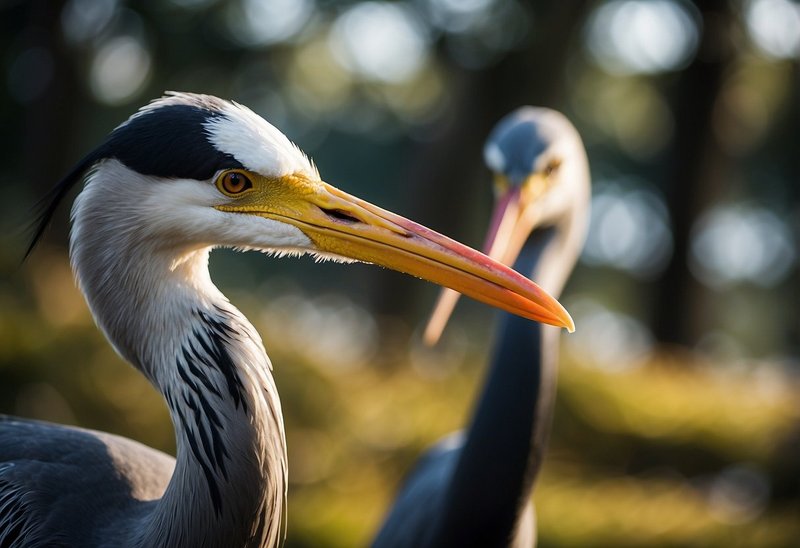
Cranes belong to a group of birds known as Gruidae. They’re not only beautiful but also possess unique behaviors and characteristics. Understanding what sets cranes apart from their feathered counterparts—like herons or storks—can help you appreciate their beauty even more. Here’s a closer look at what makes cranes special and how they differ from other similar species.
Physical Differences
Cranes are often recognized for their striking physical features. They typically have long necks and long legs, making them look quite elegant as they move around wetlands and grasslands. But what truly sets them apart is their wingspan. Cranes can have a wingspan that stretches up to seven feet! This impressive size is coupled with their unique plumage, which can range from gray to white, often accented with black and red patches on their heads.
In contrast, herons, another type of wading bird, usually have a more slender body and their necks can be more flexible. This flexibility aids them in hunting, allowing them to strike at fish with lightning speed. Storks, on the other hand, share some physical similarities with cranes, but they often have thicker bodies and shorter necks. Observing these physical traits can provide insight into how each species evolved to thrive in its environment.
Behavioral Differences
When it comes to behavior, cranes are known for their elaborate courtship dances. These dances are not merely a way to impress potential mates; they also help strengthen bonds between partners. During these performances, cranes leap into the air, synchronize their movements, and even bow to one another. It’s like watching a beautiful ballet unfold in nature! This ritual differs from herons, which are generally more solitary and don’t engage in elaborate displays, preferring to stealthily hunt for fish.
Storks, while also social birds, tend to gather in large colonies during nesting season. Their behavior is more focused on building nests and raising their young rather than the dance-like displays seen in cranes. It’s fascinating how these differences in behavior can reflect the various lifestyles of these birds.
Habitat Preferences
Cranes can be found in a variety of habitats, but they mainly thrive in wetlands, grasslands, and marshes. They love areas where they can wade through shallow waters, foraging for food like seeds, insects, and small vertebrates. This need for moist environments is one reason cranes are often spotted in protected areas or national parks.
On the flip side, herons favor similar habitats but are more commonly seen near rivers, lakes, and ponds where they can hunt for fish. Storks prefer open landscapes and usually build their nests on high structures like trees or rooftops. Understanding these habitat preferences can help you locate these beautiful birds in the wild.
Vocalizations and Communication
One interesting aspect of cranes is their vocalizations. They have a distinctive, loud call that can be heard from great distances, often used to communicate with mate or with other members of their flock. Imagine standing on the edge of a serene lake and suddenly hearing the trumpeting calls of cranes echo through the air. It’s a sound that commands attention!
In contrast, herons tend to be quieter and often communicate with soft croaks or grunts. Their less vocal nature can make spotting them in the wild a bit more challenging. Storks, while they do make some sounds, don’t have the same impressive vocal range as cranes. Their communication is usually more about visual signals rather than auditory ones, which adds yet another layer of difference among these species.
Dietary Differences
Diet plays a crucial role in distinguishing these birds as well. Cranes are omnivores, which means they eat a variety of foods, including plant material, insects, and small animals. Their foraging habits can vary depending on the season and local food availability. So, next time you see a crane poking around in the mud, they might be looking for a snack!
Herons, on the other hand, are primarily carnivorous, with a diet that mainly consists of fish, amphibians, and small mammals. They utilize their sharp beaks to catch their prey swiftly. Storks have a more varied diet too but often lean towards insects, crustaceans, and even small rodents. These dietary preferences not only reflect their hunting techniques but also illustrate how different environments shape the lifestyles of these birds.
Conservation Status
Cranes often find themselves facing threats from habitat loss, climate change, and hunting. Many species of cranes are considered endangered or vulnerable, which underscores the importance of conservation efforts. Organizations around the world are working hard to protect their habitats and ensure their survival for future generations.
Herons and storks also face similar challenges, but it varies widely depending on the species and region. Some heron species are more adaptable and thrive in urban areas, while others struggle in changing environments. Storks tend to do well in agricultural landscapes but may be affected by pesticides and habitat destruction. Recognizing these conservation statuses can help us understand the urgency behind protecting these wonderful birds.
Understanding the differences between cranes and similar bird species like herons and storks opens up a world of appreciation for these magnificent creatures. From their physical characteristics and behaviors to their diet and conservation status, each bird brings something unique to the table. So next time you see a crane strutting through a wetland, remember that it’s not just a pretty face; it plays an important role in our ecosystem.
Recognizing these distinctions can deepen your love for nature and encourage a sense of responsibility in protecting the habitats these beautiful birds depend on. Whether it’s through watching a dance or listening to their calls, cranes and their feathered friends enrich our world in countless ways. Let’s continue to explore and protect their beauty for generations to come.

